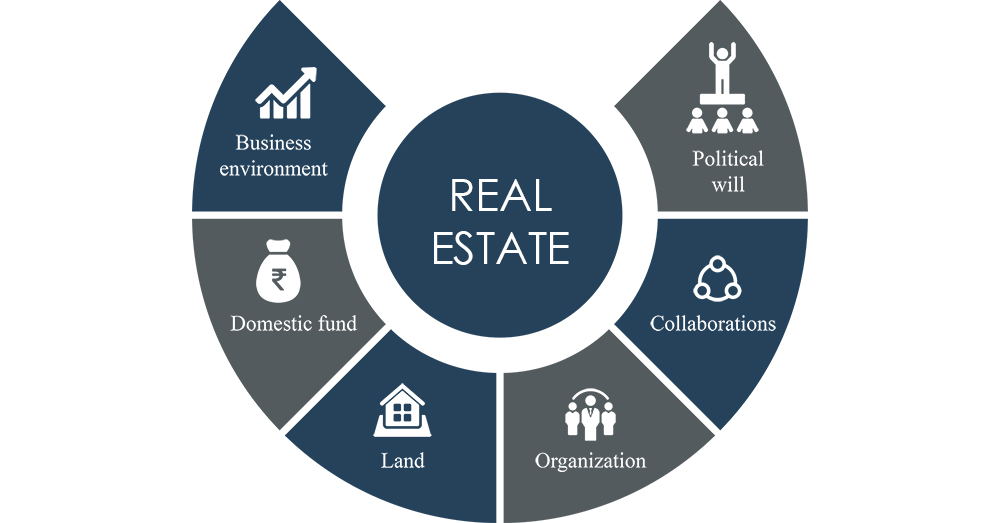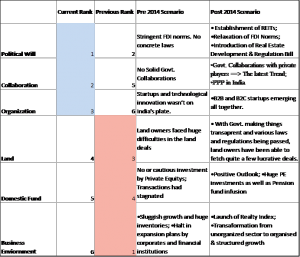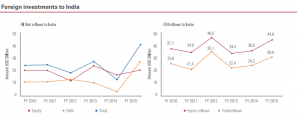613849941728389396
497545041723524926
497545041723524926

Impact of demonetisation on different segments of the real estate market
Different segments of the real estate market, like primary, resale, land, will be impacted differently by the recent demonetisation. Rxprt analyses how each segment is likely to fare in the short to long term
Many people who have recently sold their properties and accepted partial payment in cash, have no option but to declare the amount and pay taxes on it. Demonetisation has resulted in a slowdown in sales, as buyers and sellers wait for cash availability to normalize.
The primary market (purchase of properties directly from developers) will not be affected much because it is already at the bottom of the price trends and further corrections are not possible. Moreover, the primary market is mortgage driven, especially at the lower and mid-end and will not face many problems. However, the luxury segment could see a bit of correction.
Land sales and the secondary (resale) market are likely to be hit for some time though due to the liquidity crunch, as investors wait for better returns.
Will demonetisation result in all white property deals?
Property consultants maintain that in the primary market, nearly all the reputed builders in metros, have stopped taking cash. With transactions occurring through accounted payments, such as cheques, demand drafts or bank transfers, experts opine that the primary markets will not be affected.
Nearly 90% of the primary market in the metros, will not be impacted. The tier-2 and tier-3 cities will surely be affected though as the cash component is relatively higher in these cities.
Demonetisation may also cause a slight spike in distress sales. Earlier, consumers with ready payment abilities, were able to bargain and get a good deal. Now, this may be more unlikely.
Demonetisation’s impact on artificial inflation
A common belief is that the real estate market is artificially inflated, due to the circulation of black money. However, developers maintain that this is not true for primary markets, as investors are no longer present in this market. “The primary reason for this, is that the return on investment in properties for investors, is not sufficient. The purchasers are actual end-users. Thus, there should not be a significant effect on the prices.
Inflated property prices are a result of the presence of black money. As a result, the prices of resale flats will come down by 20%-40%. With demonetisation, such artificial demand will go down in the medium term, which is a major positive for realty.
If a seller is unable to accept a ‘black’ component for the sale consideration, he may simply ask for the entire consideration in ‘white’ and levy on the purchaser, all the taxes that will be additionally incident in the process, resulting in increased prices. The same thing could happen in the primary market, if upstream transactions have unaccounted components.
In this scenario, recent laws on real estate, like RERA, GST, and Real Estate Investment Trusts (REITs), can bring in the much-needed transparency and increase buyers’ confidence in the real estate market.
Which property markets will be affected by demonetisation?
- Nearly 90% of the primary market in the metros will not be impacted by demonetisation.
- Tier-2 and tier-3 cities are likely to be affected, as the cash component is relatively higher in these cities.
- Land sales and the secondary (resale) market are likely to be affected for some time, due to the liquidity crunch.

5 Ways in which currency demolition will impact the real estate sector
While the nation is still coming to terms with the Government declaration of demonetisation of cash notes of Rs 500 and Rs 1,000 We analyses what this decision means for the real estate market..
Unaccounted money, popularly known as black money, has been a major cause for concern in the Indian economy for quite a while. Since the real estate sector is accepted to be an unmistakable conductor for such funds, the recent demonetisation of Rs 500 and Rs 1,000 notes is expected to significantly impact this sector.
The role of cash in real estate transactions:
# Real estate is a major sector, where black money is parked.
# The lack of a standardised and transparent mechanisms for property valuations, make cash transactions a reality, in this sector.
# Anomalies in circle rates, also encourage the flow of cash in real estate transactions.
# Secondary market transactions, generally have a higher cash component, to save on stamp duty costs.
Industry experts are unanimous in their belief that this move will augur well for the real estate market in the long run. This choice is an enormously positive stride for the Indian real estate industry, the impacts of which are relied upon to be extensive and quick. While this sudden nullification of higher cash notes will shake up the segment significantly, it in without a doubt a stage in the right bearing.
Short term adverse effects
A change of this extent will undoubtedly confront some underlying hiccups and this may convert into less exchanges in the property market, especially the resale market, which has the most noteworthy contribution of money segment. Level II and III markets are likewise going to be seriously affected in the short keep running as money exchanges here frame a noteworthy lump of property deals, taking up as much as 70 percent of the exchange esteem sometimes. The luxury housing market is likewise liable to confront a noteworthy brunt of this sudden change since it is accepted to be prominent among those holding black money. This choice additionally comes as a noteworthy hit to other first-class buys, for example, land assets, which have a tendency to draw in huge money exchanges.
End of corruption in real estate
The biggest advantage of the demonetisation of higher cash notes is that it will eliminate black money to large extent in the nation. By cutting the flow of black money into real estate, this move will cut down corruption in the sector. The exchanges which went unaccounted due to being managed in real money will now go under the government scanner . Gera includes that stringent policies will guarantee that corruption stays under control in the long haul too.
Enhanced transparency
The effect of this move is expected to be huge in the business sectors where money payment is the standard. This move will advance cashless economy and therefore, will bring transparency in the segment, especially in purchase of lands. It will likewise put a keep an eye on the norganised developers and the here now gone again later players who tend to dupe people through unaccounted transactions. This is probably going to work couple with alternate strides being taken by the government, for example, the Real Estate Act and will most likely benefit the transparency of the sector.
Greater foreign investment
Stricter measures against black money will give the Indian real estate industry upgraded validity and enhance the general monetary assumption. Enhanced market tranparency and a positive government attitude about policy reforms will play a major part in attracting greater foreign investment into the realty sector.
Realistic price points
Another major impact of this decision will be a descending push on property prices, including land. This stems from the expectation that investors will now be not able to convey their unaccounted funds in real estate, which in turn will compel developers to set lower costs. Experts suggest that value redresses of around 10 to 30 percent may happen depending upon the market. The deflationary impact in general and more specifically on real estate prices will be a boon for affordable home prices. While the immediate market sentiment might be a little uncertain due to the suddenness of this move, experts are confident that the future holds great promise for the real estate sector.

Shift in Indian Real Estate Industry
Though residential real estate market has been a bit bogged down by the dip in demand and high inventory levels, commercial real estate on the other hand has witnessed green shoots of late. According to a report by KPMG- Real Estate Opening doors, it is estimated that the size of Indian real estate sector may increase by as much as 5 fold i.e. to $ 676 billion by the FY 2025. Our country has an urban population that is equivalent to the sum of population of USA and UK. With more than 10 million people moving to cities annually a strong growth potential lies ahead on road for us. Here is a small report as to how India’s journey has been and would be in the coming years.
| Unit | 2014-15 | 2015-16 | 2016-17 F | ||
| Macroeconomic outlook | |||||
| GDP | % (Growth) | 7.3* | 7.6 | 7.9 | |
| CPI Inflation | % (Average) | 6.0 | 4.9 | 5.0 | |
| 10-year G-Sec | % (March-end) | 7.7 | 7.5 | 7.3 | |
| Exchange rate | Re / US$ (March-end) | 62.6 | 66.3 | 66.5 | |
Source:CrisilResearch
What we have done is we here have analyzed 6 factors that have been changing the scenario in the real estate sector since 2014. So a comparison of these six, post and pre 2014 would definitely help to capture how the tide has been changing in the commercial real estate sector.
# Political Will
The Indian government in the past few years has taken noteworthy steps for various landmark reforms to attract foreign investment. India has been one of the few economies with a positive and favorable economic outlook in the past few years. Efforts by the government to improve the economy has prompted global investors to invest in India. A new land acquisition has replaced the veteran legislation. Accordingly, Real Estate Development and Regulation Bill has streamlined an approval system and a real estate regulator is expected to be appointed in each state. Increasing levels of Income of the people and the opening up of the sector to foreign direct investment has really changed the real estate sector outlook and it has witnessed phenomenal growth. The government in the last fiscal removed all restrictions on FDI in real estate. There is no lock in period for FDI investments into hotels, resorts, SEZs, NRI investments. This will definitely improve the liquidity scenario and will also speed up the investment process which earlier used to take a lot of time due to the structuring of the vehicle (SPV) to be compliant with FDI vehicle projects.
Source: – KPMG- Challenging the Tides
FDI and FII inflows post 2014 touched record high numbers with FIIs investing USD46 Billion in FY15 which was 5.3 times the investment in FY14 and FDI investments increased by 24% in FY15 in comparison to FY14.
# Collaborations
Among the latest trend, government has shortlisted smart cities that it plans to build in collaboration with an international organization- Bloomberg Philanthropes. Shortlisted cities will receive INR 1 Billion grant for five years. Leading developers in India are already collaborating with global luxury brands and hotel chains thus scouting for new ideas to attract HNIs. Such collaborations between government and private sector players will definitely impact the success, outcome and progress of the real estate sector. Though according to Modiji smart cities would have technology based solutions, the first 33 smart cities that have proposed reveal that 73% of the projects are expected to be construction intensive and a significant amount of construction spends are expected in future. Smart cities are expected to offer large scope for real estate price appreciation over a long time.
# Organization
With startups growing prominently in India, Real estate sector is not far left behind where a lot of B2B and B2C startups have started working alongside the real-estate sector. Various B2B startups have set up online user friendly platforms that provide online access to buyers and sellers of commercial real estate nationwide. Thus agents/ brokers using the online platforms to run their businesses more effectively and efficiently is a wave of innovation. Improved data management in the real estate sector where information on how transactions happened between the buyers and sellers and brokerages with the best data making the most money will definitely democratize commercial real estate nationwide. Also there are provisions for initial challenges for startups such as outlay of heavy capital investment and a long gestation period however in the long run it presents an improved quality of life and an integrated environment for everyone.
# Land
Owing to better macro-economic outlook and corporate expansion since 2014, the Indian IT, Information Technology Enabled Services, the BFSI sector have strengthened in the last couple of years. Where the IT sector is poised to further grow and strengthen, the Indian commercial real estate sector has drawn along this growth. The commercial office market has proliferated with a surge in the absorption levels across all the major metro cities and non-metro cities. According to a report by KPMG the total commercial office space absorbed between H1 2014 to H1 2015 was 58081 Mn sq. ft. with Bangalore witnessing the maximum absorption followed by Mumbai, Gurgaon and Pune. Previously i.e. before FY 2013/14 the economy slowdown and low demand had led to disappointment among the real estate players. Even the landowners were a bit resilient as they could not fetch lucrative prices which had eventually happened because the customers had lost confidence in the completion of the projects and were not willing to buy.
# Domestic Fund
Till the global economic downturn and post that for few years, India’s major sources of funding in the Real Estate sector were QIP, NBFCs, Bank lending and private lending. Private Equity had a very small percentage in the entire pool. But post 2013, driven by high returns on investments, the sector observed huge capital deployment from the PE funds. Also corporate developers went a way ahead and looked for funds through the capital markets which eventually reduced the overall dependence on banks. The NBFCs and PEs have been gaining importance ever since the banks reduced the pool of credit to commercial real estate in the last half a decade. According to a report by KPMG, the credit given by banks to commercial and residential real estate has declined from 10% to 8% in the past half a decade.
Source:-KPMG, challenging the tides
Given the signs of improvement and yield curves stabilizing post the new “ache din” government an upward trend can be observed in terms of value and investment by funds in the number of deals driven by domestic fund managers. Also a large bunch of sovereign and pension funds, which are generally long term, infused funds into the real estate sector. By large, increasing occupancy levels along with stable rentals and significant scope of capital appreciation has validated the increased investments by the domestic fund managers.
# Business Environment
From being a mostly an unorganized sector in the past, the real estate sector has transformed to a more structured and organized sector. This could be attributed to investments by a lot of Private Equity and strategic investments that took place and a lot startups that have taken the initiative and streamlined as well as made the real estate business look efficient. Channels such as Private Equity in the real estate sector have gained significance since the time cash flows from other source of investments had moderated during the period 2009-2013 due to low and slow growth, currency depreciation and inflation. Other sources of investments here mean capital markets, banks or private lenders. Until 2014, the demand in the real estate sector was very sluggish which had led to high inventories. There were hardly or cautious PE funding (if any) as the focus was mostly on structured debt deals. But post 2014, introduction of schemes such as housing for all, REITs, Smart Cities initiative, Real Estate regulation and development bill led to the revival of the sector. Also increased investments by the PE investors and selective penetration by sovereign & pension funds did improve the confidence in the prospects of the sector.

How Social Media Can Be Every Realtor’s Best Friend
Technology is man’s best friend now. With the advent of apps like Facebook and Twitter, people share information in just a wink. Millions of data are getting shared on social media daily. Be it on lifestyle, technology, entertainment or real estate.
So, how can you, being an agent gain access to thousands of people? What information should you post that can make people go WOW? And that too about real estate?
Make it official
It is always prudent to not use your own account when you post real estate news or list any property. Especially, if you are an agent who would like to list properties online or in social media, you should create an official email ID as well as a social media account. It is also advisable to use an official phone number and not provide your personal cell phone or landline number when you post on Facebook.
To create a social media account name you should use your real estate agency’s name. Choose something appealing and genuine enough.
Make it wide
When you post about a property it is a thumb rule to describe the locality, the neighborhood, and accessibility to nearby areas. If you are a real estate agent, it is good to start a social media account starting with articles or blogs describing every area that you will be handling properties in. In this way, you can list your properties later with a link to this blog that carries the neighborhoods info.
Use only articles that describe the real estate boom in a particular area and not the downfalls or the cons of any area as they may result in a change in people’s thoughts when they look for the locality info.
Make it appealing!
Very boring, lifeless listings aren’t fun, especially when it comes to social media. Use authentic pictures of properties and bring out creativity when you market a house in any area. Also, it is best if the property that you are promoting is on the maps. So, geotagging properties when you list them is another great method to promote properties.
Use good quality, clear pictures. They have the capability to make even a small house appealing and attractive if not huge. And watch for the arrangement of things inside the house which may add a lot of credit to the whole backdrop of your image.
Make it interactive
The viewers and readers must be engaged when they read posts from you. So, make them very inquisitive whenever they see your blog. You can create contests and give the winners some fee waiver or vouchers when they do business with you. You can promote your page with a meagre amount that the social media providers provide in order to gain more followers.
Creating voting contests, for example, which area is flourishing in the real estate field or which of these two houses look more beautiful and more such polls can be created for you to know your viewer base, increasing them at the same time.
Make it non-serious
Real estate isn’t that much of a serious field. Let your readers know that! Posting articles like gardening tips and flooring options may make them be more involved and would love to have a good read.
Posting interesting content and not just the listings will let more people follow or like your page because of the content you post if not for the listings. Chances are, a few may get interested on your property listings too!
Make sure your page looks interesting, exciting and engaging enough when you look at it in a viewer’s perspective. Gain the most from your social media page. Get more likes, more followers and a lot of retweets making yourself the king of the social media real estate!

GST : Will it have an impact on the Real Estate Industry ?
The goods and services tax (GST), cleared by the Rajya Sabha on Wednesday, is expected to benefit the real estate industry, though the impact will depend on the final GST rate.
The real estate sector is one of the fastest growing sector in India and contributes about 7.8% to India’s GDP and is the second-largest employment generator after the IT industry.
Presently this industry has two primary levies, Service tax and VAT, with overlap of tax base and constant disputes on the rate of tax, given the multiple options available for discharge of taxes across States. This has resulted in diverse practices being followed by developers, across geographies and even within each State. These issues should be put to rest under the GST regime and the practices and positions should be common across India. Hence, the taxes paid by a home buyers across States should more or less be the same.
There are also various elements of non-creditable tax costs, like excise duty, customs duty, CST, entry tax, etc paid by the developer on his procurement side, which is inbuilt into the pricing of the units. All these tax costs add upto anywhere between 22%-25% of the price of units. The proposed GST should replace these multiple taxes with a single tax and should also ensure smooth flow of credits through the chain. Hence, it is widely expected that GST should reduce the construction cost in the hands of the developer and thereby aid in reducing or atleast maintaining the current level of prices in the real estate sector. The only dampner could however be high GST rates (like the 27% GST rate that is doing the rounds) which will offset any possible gains on incremental credits. Stamp duty is not proposed to be subsumed under GST and hence will continue as it is today.
See also: Existing Tax Reforms
We have analyze the effect of GST on various Realty Sector :
Construction :
Sale of constructed (immovable) property:
GST is levied on supply of goods and services. Hence, sale of property after construction (i.e., immovable property) should be outside the ambit of GST. However, stamp duty on the sale of immovable property would continue to be levied.The only difference would be that the current multiple taxes on procurement side would get replaced by GST and that there would be a rate difference in the current taxes and the rate of GST. The difference in rate, upwards or downwards, would accordingly impact the property prices.
Sale of under-construction property:
Sale of under-construction property is likely to be covered within the ambit of GST. A clause in the Model GST Law states that credit of GST paid on goods and services acquired for construction of immoveable property (other than plant and machinery) would not be available. This clause is a cause of concern as it is ambiguous and interpretative which may lead to litigations and denial of credits for this sector.
Construction of property for leasing
The activity of leasing of immovable property is likely to qualify as a service under the GST regime and would accordingly attract GST. In today’s regime, leasing of immovable property for commercial purposes attracts service tax whereas leasing for residential purposes is in the negative list and does not attract service tax. The same regime should continue under GST.
For commercial properties, though service tax is applicable on lease rentals, the input tax credits are not available under the current regime. In the proposed regime, GST is likely to apply on lease rentals; the issue for consideration is whether credit of GST paid on procurement of goods and services would be available or not.
Real Estate Developers :
There are a few clarifications that might be sought for GST taxation by real estate developers. For instance, the definition of a real estate developer varies from one state to another in India. The composition scheme varies according to State, in which the VAT rates come between 1-5%. In some States, there are differences between the terms real estate contractors and real estate developers. It has to be understood what will the GST implications are if the terms have different meanings.
There might be some confusion regarding GST implementations on residential property, as well. In the present scenario, there is no service tax applicable on renting immovable property, particularly for residential purposes. But service tax and VAT is implemented on the construction work. The question that arises is if the proposed GST will offer differential tax for residential properties.
As of now, it does not look like completed residential projects will be affected by GST, as buyers into completed projects have already paid statutory charges such as stamp duty and registration charges on the transaction. The segments to watch on the GST front are under-construction and rental flats, which are expected to come under the ambit of GST. GST will apply to the materials that a developer procures for building a residential project, so there is a direct correlation to the overall cost of construction.
A lot depends on what rate of GST will finally be confirmed. If it is more than the existing cumulative taxes currently in force, it means that the overall cost to consumers of buying an under-construction flat will increase along with the added cost of stamp duty and registration. At the same time, developers have to keep an eye on costing, as price competitiveness is very important in the current real estate market scenario.

Historic (Goods and Services Tax) GST Bill passed in Rajya Sabha
The Goods and Services Tax (GST) Bill, one of the most ambitious tax reforms in India is finally passed by the Rajya Sabha on August 3, 2016 and is expected to be implemented from April 1, 2017.
What is GST?
The Goods and Services Tax (GST), is a kind of a comprehensive indirect tax on sale, manufacture and consumption of different kinds of goods and services throughout India, with all other Central and State taxes intended to be subsumed under it.
Why GST is important?
GST subsumes all indirect taxes levied by the Centre and the states, including excise duty, service tax, value-added tax, luxury tax and entertainment tax. It will remove all barriers across states and make the country a common market. It is expected to add up to 2% to the gross domestic product, once implemented successfully.
Existing Taxation Norms
The real estate industry in India has witnessed major tax changes, in the last few years. However, these taxes are not uniform all over the country – different practices and regulations are followed in different states. It was the 46th amendment to the constitution that brought massive changes towards taxation in the real estate sector. Subsequently, special powers were given to the state governments, for implementing Value-Added Tax (VAT) on some specific kinds of transactions.
For land, property and other kinds of work contracts, different kinds of taxes are levied by the state government and the central government. The transactions are mainly categorised in three parts – value of services, value of goods and materials, and value of land. VAT is applied by the state government on the goods portion, while value of services is taxed by the central government. However, other than stamp duty, there is no clear tax on the transactions regarding value of land. This situation leads to confusion and can result in dual taxation. Compliance and implementation of such taxes are also difficult.
This has led to a situation, where for one real estate transaction, multiple taxes need to be paid. This has a negative effect on the industry.
The industry’s demand to bring GST on board, is primarily to get a clear and transparent taxation rule for the real estate sector in India.
Impact of GST on Indian Real Estate Industry
The implementation of GST can prove to be a significant step in reforming indirect taxation in India. Chances of double taxation would be diminished, as some of the Central and State Government taxes will be amalgamated into one tax. This will ease the process of taxation considerably, making its enforcement and administration easier and simpler.
In the current situation, a developer incurs various kinds of expenses during the construction phase of a project. Different kinds of taxes are involved with these expenses, such as VAT/CST, customs duties, service tax, excise duty, etc. A majority of these taxes, are expenses that are included in the system. This is because they are not creditable to the developer or to the end-customer. These non-creditable expenses lead to tax inefficiency, which is not desirable.
One positive impact of the GST, could be the doing away of restrictions on credit utilisation. This will definitely help in strengthening the credit chain in the entire system. If builders can properly manage this aspect, they will see some profit.
Expert Views on GST Bill
Anshuman Magazine, Chairman, CBRE – India and South East Asia
“The GST Bill has been long awaited by the industry. This is a major tax reform for our economy, which will transform India into a single market. The passage of this Bill is likely to positively impact the real estate sector, which has linkages with over 250 ancillary industries. Unified taxation will also infuse the much needed transparency into our taxation system. Overall, the Bill is expected to have a long lasting and progressive impact on the economy, enhancing the prevalent business sentiment in the country.”
Ankur Dhawan, Chief Buisness Officer, PropTiger.com
“With the uniform tax, developers will have free input credits on GST paid for services and goods purchased by them which will reduce cost for them and can be passed as reduction to buyers. For commercial property, GST will reduce taxation as developers will be able to get input credit of GST paid for construction services against the GST charged on lease rentals. In the long run if GST can help increase GDP by 2% as predicted by experts it will in turn drive the demand for real estate hence helping real estate industry.”
Parveen Jain, President, NAREDCO
“The enactment of this law will single-handedly solve many of the challenges faced by the real estate sector and help in pulling the sluggish sector out of its long slumber. Heavy taxes that are being paid currently by the developers will automatically go down by a considerable percentage. Construction costs would be reduced to some extent and this benefit could be passed on to the customers, thereby triggering transactions in home buying. There would also be a positive impact on the commercial property segment, as commercial real estate which is already starving from funds could see some kind of a revival.”
Vineet Relia, Managing Director, SARE Homes
The implementation of GST is likely to improve transparency and reduce tax evasion on account of better enforcement and compliance. The home buyer in general could benefit from the introduction of GST if the rates are moderate. The fact that works contract would be taxed as a service under the model GST law is a welcome move and is expected to provide certainty on taxability of the construction sector. This should lead to reduction in tax costs as the tax would be now charged on the actual contractual base and there would not be any overlap of VAT and service tax on a certain portion of such contracts like under the current regime
Anuj Puri – Chairman & Country Head, JLL India
In terms of cost reduction for manufacturers, the current tax structure has three layers at the central, state and city-levels, manufacturing units have to shell out a good amount of money to transport their goods. They end up paying multiple taxes on the transportation. Once GST is rolled out, there will be a common tax structure and thus, the burden of paying multiple taxes will go away. Such units will not have a varied tax structure for transportation of their goods to different locations and will not have to pay each time they transport goods, thus, reducing the overall cost. Likewise, there will be a cost reduction for logistics players, as logistics players create a stock transfer between inventory stocking points within states to avoid a multi-tax scenario.

Lok Sabha clears Bill for quicker, easier debt recovery
The Lok Sabha passed a crucial Bill that will pave the way for faster resolution of bad loans for banks and provide for swift action against ‘wilful defaulters’.
The Enforcement of Security Interest and Recovery of Debts Laws and Miscellaneous Provisions (Amendment) Bill, 2016, passed by voice vote, seeks to amend four laws — Sarfaesi Act, DRT Act, Indian Stamp Act and Depositories Act. Finance Minister Arun Jaitley said the banks must be empowered to take effective legal action against defaulters and the insolvency law, securitisation law and DRT law are steps in that direction. At the same time, he assured the House that banks will take a compassionate view on education loan defaults but there will be no waiver.
The changes in the Sarfaesi Act allow secured creditors to take over a collateral against which a loan had been provided, upon default in repayment. It also provides that the process will have to be completed within 30 days by the district magistrate.
“The present law simplifies the procedure by which there will be quick disposal of pending cases of banks and financial institutions by the Debt Recovery Tribunal,” Jaitley said.
“We cannot have a banking system where people take loans and do not repay. We should not create a culture that I have taken a loan and I can sleep well and banks should be answerable,” he said.
M Rajamohan Reddy (YSRCP) said the bill will improve the ease of doing business by providing a fast-track mechanism to deal with the bad loans of the bank.
Jagdambika Pal (BJP) expressed the hope that the changes in different Acts would help in reducing the non performing assets (NPAs) in the banking sector which are reported to be over Rs 5 lakh crore.

Single window clearance could drive down realty prices
The government is pushing for online application of building proposals and common application forms for approvals, from various departments. Will these moves ultimately benefit home buyers, by reducing property costs?
The construction industry is eagerly waiting for the single-window clearance of all approvals within 30 days, to be implemented. The procedure is at the final stage of implementation.
The Brihanmumbai Municipal Corporation (BMC), announced that they have started online acceptance of documents for building proposals, from May 15, 2016. The civic body has integrated approvals pertaining to the fire and water departments, while the integration of clearances pertaining to coastal regulation zones and forests, owing to the national park located within the city, are underway.
In Delhi, the municipal body has unveiled a four-page Common Application Form, in the north, south and east zones. According to officials of the Municipal Corporation of Delhi (MCD), 10 agencies including the Heritage Conservation Committee, Delhi Urban Arts Commission (DUAC), Delhi Fire Services and Delhi Jal Board, have been integrated with the common form, thereby, doing away with the need for applicants to separately approach these agencies for no-objection certificates.
The online approval process will be implemented, with the help of the National Monuments Authority’s (NMA’s) web portal called ‘NOC Online Application and Processing System (NOAPS)’. The NOAPS has been integrated with the online portals of the Municipal Corporation of Greater Mumbai (MCGM), the New Delhi Municipal Council (NDMC) and south, north and east zones of the MCD. Developers will now need to fill a single form which will be sent to the concerned agencies by the local body. The NMA will also give approvals to the local body, within six working days, down from the present time limit of 90 days.
Multiple approvals, delays and its impact
Developers on their part, have consistently complained that they face multiple hardships owing to delays in obtaining approvals. Zaheer Majeed Memon, partner, Zara Habitats, explains, “We have experienced a lot of delays, owing to the lack of a streamlined system for obtaining approvals. Lack of clarity in interpretation of regulations and multiple windows for obtaining permissions, increase the time taken for projects to commence.”
As a result, in the past few years, numerous complaints have been filed in the consumer courts against developers, for delays in the delivery of flats.
Kishor Pate, CMD of Amit Enterprises Housing Ltd is of the view that “Delivery timelines play a big role in determining how attractive a developer’s project is to investors and how much confidence end-users will have in a developer. In other words, developers not only suffer financial loss because of approval delays but also lose credibility. Now, with a single-window approval system, residential prices are expected to come down by 30%-35%.”
Harjith D Bubber, MD and CEO of Rivali Park, adds that hassle-free clearances will help under-construction projects, by reducing delays and the cost of the projects. Faster approvals will also help developers to start construction of their projects on time and keep it within the planned budget, by avoiding year-on-year inflation in costs.
Benefit to the end-users
By saving time and cutting costs, single-window clearances will eventually benefit the consumers. According to Ramesh Nair, COO – business and international director, JLL India, the government’s move towards a single-window system, will improve the supply pipeline. “It will increase competitiveness among developers and thereby, serve to manage pricing. This will work in favour of end-users. However, it could also bring about over-supply, if developers are not intelligent about their launch choices,” he concludes.



